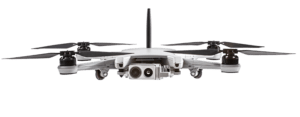As the U.S. drone industry continues to develop, new developments in commerce regulations may make it easier for U.S.-based drone manufacturers to access the global marketplace.
Flexibility is the Key to Airpower: More Developments in Drone Export Controls
By DRONELIFE Guest Contributor Dawn M.K. Zoldi*
On January 12, 2021, the Bureau of Industry and Security (BIS) of the U.S. Department of Commerce (USDOC) issued a new rule changing the license review policy to add flexibility for exports of unmanned aerial systems (UAS) that are controlled for missile technology (MT) reasons.
The rule amends the United States’ (U.S.) Export Administration Regulations (EAR) to reflect the President’s July 24, 2020 policy updates. These updates softened the implementation of the Missile Technology Control Regime (MTCR)’s strong presumption of denial for transfers of Category I systems and instead treated “a carefully selected subset of MTCR Category I UAS (maximum airspeed less than 800 kilometers per hour) as Category II.” This allows for a more liberal case-by-case review and opens up trade opportunities for some U.S. drone producers. The rule is effective immediately.
The MCTR, formed in 1987 and of which the U.S. is a founding member, is a multilateral effort to combat missile proliferation. It’s mission is to, “ to coordinate national export licensing efforts aimed at preventing proliferation of unmanned delivery systems capable of delivering weapons of mass destruction (WMD).” To do this, its 35 member nations collaboratively establish international guidelines for common controlled items and related export policy to use a benchmark for their own national policies. Members voluntarily agree to adopt the Regime’s Guidelines for Sensitive Missile-Relevant Transfers (MTCR Guidelines) and to restrict the transfer of items contained in the Regime’s Equipment, Software, and Technology Annex.
The Annex consists of two categories. Category I, the most sensitive, include rocket systems and UAS with a range capability of 300 km and greater and a payload capability of 500 kg and greater, as well as their production facilities and major subsystems. Category II, less sensitive and with many uses other for delivering WMD, includes rocket systems and UAS with a range of 300 km or greater but below a payload capability of 500 kg. Because of this distinction, the Guidelines attach a strong presumption of license denial to Cat I drones and allow for a more lenient individualized review of Cat II drones. The U.S. previously adopted this approach in Section 742.5 of the EAR.
For the past four years, the U.S. has unsuccessfully tried to build consensus to update the MCTR Guidelines consistent with U.S. policy and “to address the ongoing revolution in both UAS technology and its applications.” Thus, this latest move is unilateral.
The rule specifically adds a Note to paragraph (b)(1) of EAR Sec. 742.5, largely disavowing the strong presumption of denial for Cat I drones and replacing it with the same case-by-case review standard used for Cat II. The rationale is that Cat I drones can also be used for non-security related commercial purposes.
There is a significant caveat here. The new USDOC rule still tows the line on Cat I drones that are widely used in intelligence, surveillance, and reconnaissance (ISR) missions and also could be used for delivering WMD (e.g, cruise missiles, hypersonic aerial vehicles, and advanced unmanned combat aerial vehicles). These will still be subject to a strong presumption of denial if they are intended for use as WMD delivery systems, or if they present a risk of diversion to such an end use, to strike a balance in the desire to allow the commercial drone industry to thrive with the need to take non-proliferation seriously.
This is the same strong presumption of export license denial at play in recent updates to the U.S. the economic blacklist. In late December 2020, the BIS added DJI to that list to control the flow of the U.S. items, tech and source code to individuals, organizations and to them. Additional licensure is now required for exports, reexports, or transfers to the Chinese-based company, but requests will presumptively be denied. Conversely, this USDOC rule scraps that presumption for U.S. export of certain MT-related drones “to help allies and partners meet their urgent national security and commercial requirements.”
The USDOC estimates this rule change will affect twenty license applications per year. As they say, “Flexibility is the key to airpower.” So too, with export controls.
*The views and opinions in this article are those of the author and do not reflect those of the DOD, do not constitute endorsement of any organization mentioned herein and are not intended to influence the action of federal agencies or their employees.
 Dawn M.K. Zoldi (Colonel, USAF, Retired) is a licensed attorney and a 25-year Air Force veteran. She is an internationally recognized expert on unmanned aircraft system law and policy, the Law-Tech Connect™ columnist for Inside Unmanned Systems magazine, a recipient of the Woman to Watch in UAS (Leadership) Award 2019, and the CEO of P3 Tech Consulting LLC. For more information, visit her website at: https://www.p3techconsulting.com.
Dawn M.K. Zoldi (Colonel, USAF, Retired) is a licensed attorney and a 25-year Air Force veteran. She is an internationally recognized expert on unmanned aircraft system law and policy, the Law-Tech Connect™ columnist for Inside Unmanned Systems magazine, a recipient of the Woman to Watch in UAS (Leadership) Award 2019, and the CEO of P3 Tech Consulting LLC. For more information, visit her website at: https://www.p3techconsulting.com.
Miriam McNabb is the Editor-in-Chief of DRONELIFE and CEO of JobForDrones, a professional drone services marketplace, and a fascinated observer of the emerging drone industry and the regulatory environment for drones. Miriam has penned over 3,000 articles focused on the commercial drone space and is an international speaker and recognized figure in the industry. Miriam has a degree from the University of Chicago and over 20 years of experience in high tech sales and marketing for new technologies.
For drone industry consulting or writing, Email Miriam.
TWITTER:@spaldingbarker
Subscribe to DroneLife here.
https://dronelife.com/2021/01/14/u-s-drone-industry-changes-in-export-control-could-help-u-s-manufacturers/
 Unmanned Aerial Vehicle The latest drone news
Unmanned Aerial Vehicle The latest drone news




